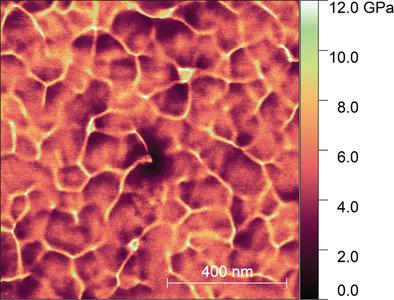当前位置:
X-MOL 学术
›
Adv. Electron. Mater.
›
论文详情
Our official English website, www.x-mol.net, welcomes your feedback! (Note: you will need to create a separate account there.)
Mechanical Properties of Organic Electronic Polymers on the Nanoscale
Advanced Electronic Materials ( IF 6.2 ) Pub Date : 2021-11-25 , DOI: 10.1002/aelm.202101019 Vishal Panchal 1 , Illia Dobryden 2, 3 , Ude D. Hangen 4 , Dimitrios Simatos 5 , Leszek J. Spalek 5 , Ian E. Jacobs 5 , Guillaume Schweicher 6 , Per M. Claesson 2 , Deepak Venkateshvaran 5
Advanced Electronic Materials ( IF 6.2 ) Pub Date : 2021-11-25 , DOI: 10.1002/aelm.202101019 Vishal Panchal 1 , Illia Dobryden 2, 3 , Ude D. Hangen 4 , Dimitrios Simatos 5 , Leszek J. Spalek 5 , Ian E. Jacobs 5 , Guillaume Schweicher 6 , Per M. Claesson 2 , Deepak Venkateshvaran 5
Affiliation

|
Organic semiconducting polymers have attractive electronic, optical, and mechanical properties that make them materials of choice for large area flexible electronic devices. In these devices, the electronically active polymer components are micrometers in size, and sport negligible performance degradation upon bending the centimeter-scale flexible substrate onto which they are integrated. A closer look at the mechanical properties of the polymers, on the grain-scale and smaller, is not necessary in large area electronic applications. In emerging micromechanical and electromechanical applications where the organic polymer elements are flexed on length scales spanning their own micron-sized active areas, it becomes important to characterize the uniformity of their mechanical properties on the nanoscale. In this work, the authors use two precision nanomechanical characterization techniques, namely, atomic force microscope based PeakForce quantitative nanomechanical mapping (PF-QNM) and nanoindentation-based dynamical mechanical analysis (nano-DMA), to compare the modulus and the viscoelastic properties of organic polymers used routinely in organic electronics. They quantitatively demonstrate that the semiconducting near-amorphous organic polymer indacenodithiophene-co-benzothiadiazole (C16-IDTBT) has a higher carrier mobility, lower modulus, and greater nanoscale modulus areal uniformity compared to the semiconducting semicrystalline organic polymer poly[2,5-bis(3-tetradecylthiophen-2-yl)thieno[3,2-b]thiophene] (C14-PBTTT). Modulus homogeneity appears intrinsic to C16-IDTBT but can be improved in C14-PBTTT upon chemical doping.
中文翻译:

纳米级有机电子聚合物的力学性能
有机半导体聚合物具有吸引人的电子、光学和机械性能,使其成为大面积柔性电子设备的首选材料。在这些设备中,电子活性聚合物组件的尺寸为微米,并且在弯曲集成了它们的厘米级柔性基板时,其性能下降可以忽略不计。在大面积电子应用中,没有必要仔细观察聚合物的机械性能,无论是晶粒级还是更小。在新兴的微机械和机电应用中,有机聚合物元件在跨越其自身微米级活性区域的长度尺度上弯曲,在纳米级表征其机械性能的均匀性变得很重要。在这项工作中,作者使用两种精密纳米力学表征技术,即基于原子力显微镜的 PeakForce 定量纳米力学映射 (PF-QNM) 和基于纳米压痕的动态力学分析 (nano-DMA),来比较常规使用的有机聚合物的模量和粘弹性在有机电子学中。他们定量地证明,与半导体半结晶有机聚合物聚[2,5-双(3-十四烷基噻吩-2-基)噻吩并[3,2-b]噻吩] (C14-PBTTT)。模量均匀性似乎是 C16-IDTBT 固有的,但在化学掺杂后可以在 C14-PBTTT 中得到改善。
更新日期:2021-11-25
中文翻译:

纳米级有机电子聚合物的力学性能
有机半导体聚合物具有吸引人的电子、光学和机械性能,使其成为大面积柔性电子设备的首选材料。在这些设备中,电子活性聚合物组件的尺寸为微米,并且在弯曲集成了它们的厘米级柔性基板时,其性能下降可以忽略不计。在大面积电子应用中,没有必要仔细观察聚合物的机械性能,无论是晶粒级还是更小。在新兴的微机械和机电应用中,有机聚合物元件在跨越其自身微米级活性区域的长度尺度上弯曲,在纳米级表征其机械性能的均匀性变得很重要。在这项工作中,作者使用两种精密纳米力学表征技术,即基于原子力显微镜的 PeakForce 定量纳米力学映射 (PF-QNM) 和基于纳米压痕的动态力学分析 (nano-DMA),来比较常规使用的有机聚合物的模量和粘弹性在有机电子学中。他们定量地证明,与半导体半结晶有机聚合物聚[2,5-双(3-十四烷基噻吩-2-基)噻吩并[3,2-b]噻吩] (C14-PBTTT)。模量均匀性似乎是 C16-IDTBT 固有的,但在化学掺杂后可以在 C14-PBTTT 中得到改善。

























 京公网安备 11010802027423号
京公网安备 11010802027423号